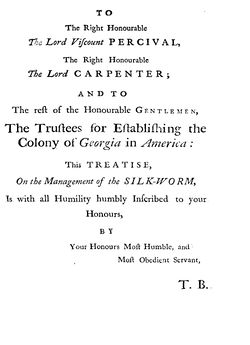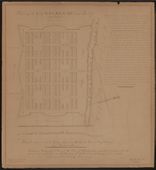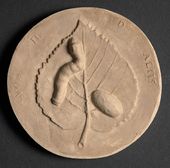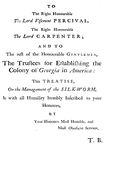Trustees’ Garden
Overview
Alternate Names: Trustee Garden
Site Dates: 1734–1748
Site Owner(s): The Trustees for Establishing the Colony of Georgia in America;
Associated People: General James Oglethorpe, founder; Joseph Fitzwalter 1734–1735, gardener; Paul Amatis 1735–1736, gardener; Joseph Fitzwalter 1737–1738, gardener; Hugh Anderson 1736–1739; Newdigate Stephens 1742;
Location: Savannah, GA · 32° 4' 37.67" N, 81° 5' 8.38" W
Condition: Demolished
Keywords: Grove; Nursery; Plantation; Public garden/Public ground; Square; Walk; Wood/Woods
Trustees’ Garden, founded in Savannah, Georgia, in 1734, is an important early example of a public botanic garden and nursery in the British American colonies. It was established to collect plants that would grow best in Savannah’s climate with the goals of encouraging agriculture and establishing profitable silk and wine industries.
History
The Trustees’ Garden, established in 1734 on behalf of the Trustees for Establishing the Colony of Georgia in America by the British military officer James Oglethorpe (1696–1785), was a public garden located in Savannah. Founded two years after Oglethorpe secured the charter for the colony of Georgia and one year after he established Savannah, the ten-acre garden was part of Oglethorpe’s original plan for the town common located on the banks of the Savannah River on the east end of the town of Savannah (on what is now East Broad Street).[1] There are no known extant images of Trustees’ Garden from the period, but one map created in 1757 includes an inscription marking the location of the “Trustees garden gate” in the lower right corner [Fig. 1]. Trustees’ Garden is an important early example of an American public garden motivated by scientific principles and of the trans-Atlantic networks of people, plants, and ideas that would characterize efforts in botany and garden design during the eighteenth and nineteenth centuries.
Driven by British Enlightenment principles and commercial interests, Georgia Trustee Stephen Hales (1677–1761) and advisor Sir Hans Sloane (1660–1753), both members of the Royal Society in London, championed the garden as a site for scientific experimentation and modeled it after the examples of the botanic and physic gardens at Chelsea and Oxford in England. Experiments in the garden would, the Trustees hoped, determine what plants grew best in Savannah’s climate. Another goal for the Trustees’ Garden was to encourage colonists to cultivate the most successful crops. To that end, the garden served as a nursery providing free seeds and saplings for farmers and gardeners.[2]
Gardeners planted a range of vegetation at Trustees’ Garden, including pear, apple, peach, orange, fig, and olive trees, as well as pomegranates, spices, and herbs. Francis Moore reported in 1736 that the garden had been arranged in different zones. English fruit trees were planted “in the coldest part of the Garden,” while fruits from warmer parts of Europe, including olives, figs, and pomegranates, were established in another section. In the most sheltered and warmest quarter of the garden, experiments growing coffee, cocoa, and cotton took root (view text - 1).
The Trustees hired botanists to supply plants from Europe, the Caribbean, and Central and South America in the hopes that some of would prove adaptable to Savannah’s growing conditions. They first retained the Scottish botanist Dr. William Houstoun (d. 1733) in October 1732 for three years to make a voyage to Madeira, Jamaica, Cartagena, Porto Bello, Campeche, and Vera Cruz. Houstoun was charged with procuring exotic specimens—especially medicinal plants and herbs, on the advice of Sloane—in these locales to send to Savannah. Houstoun died soon after arriving in Jamaica, and Robert Millar was contracted by the Trustees in March 1734 to resume Houstoun’s project. Millar established a base in Jamaica and focused his efforts on collecting medicinal herbs such as Jesuits bark (used in the treatment of malaria and fevers), ipecacuhana (an emetic), and cochineal (used as a red dye) in Central and South America, but he soon ran afoul of Spanish authorities and his trip was cut short.[3] A gardener at the Chelsea Physic Garden supplied the Trustees with various seeds, including white mulberry, potash, and cotton. Other “friends of the Georgia experiment” contributed plants, seeds, and vines from Europe and the East Indies.[4]
One of the Trustees’ main goals for the garden was to cultivate grapevines and white mulberry trees to produce wine and silk, which they hoped would prove profitable commodities for export that would benefit the British economy. In November 1732 Houstoun acquired grapevines in Madeira to support the Trustees’ interest in establishing viticulture in the colony and sent the vines to Savannah by way of Charleston, South Carolina. The Trustees also hired Paul Amatis (d. 1736), an Italian expert in silk production, to oversee the growing of white mulberry trees at the garden in Savannah, and soon brought in additional silk-makers from Piedmont to teach the colonists the art and science of silk production ().[5] The Trustees’ hopes for a silk industry in Georgia were so strong that one side of their official seal featured a silkworm on a mulberry tree leaf [Fig. 2]. In addition, the Trustees sent twenty-five copies of the illustrated instructional treatise A Compendious Account of the Whole Art of Breeding, Nursing, and the Right Ordering of the Silk-Worm, published in London in 1733, to guide the colonists in raising silkworms [Fig. 3].[6] By 1740 nearly the entire Trustees’ Garden plot was turned over to the cultivation of mulberry trees.[7] Despite these efforts, the Trustees’ expectations for prosperous silk and wine industries in the colony ultimately failed to materialize.
Although Trustees’ Garden flourished soon after its founding under the direction of Oglethorpe and the first head gardener, Joseph Fitzwalter, its early success was ultimately short lived. Despite the Trustees’ ambitious plans for the garden, several miscalculations doomed the experiment early on. Specifically, the Trustees misjudged Savannah’s climate and the fertility of its soil, mistakenly believing that it was equivalent to that found around the Mediterranean because of its similar latitude. They thus focused on cultivating crops that were ultimately unsuited to the site.[8] Hugh Anderson, a Scotsman who was given the role of “Inspector of the Public Garden and Mulberry Plantations,” later described the Trustees’ Garden in unflattering terms as “a barren Piece of Land, where it is hardly possible for what is planted to live, but impossible to thrive” (view text).
The garden’s managers also mishandled the labor needed to grow and maintain the site, and the endeavor was plagued with staff turnover and internal disputes. The garden suffered neglect after Fitzwalter left abruptly for South Carolina in 1735, possibly due to frequent disputes with Amatis regarding the garden’s management. Anderson attempted to revive the gardens to their once-flourishing state by rehiring Fitzwalter as head gardener in December 1737, and the conditions in the garden seemed to improve for a short time. However, a spate of bad weather and labor disputes with indentured servants who worked in the garden ultimately proved too severe to overcome. The Trustees in England received an eye-witness account in February 1738 reporting food shortages in Savannah and that half of the trees in the Trustees’ Garden had died from neglect. Oglethorpe removed Anderson from his role in October 1739, and Anderson later co-authored an attack on Oglethorpe in the True and Historical Narrative of the Colony of Georgia (1741).[9]
Ultimately the endeavor was short-lived, and Trustees’ Garden was largely abandoned by 1748, by which time, the land had become a residential area. Fort Savannah (later Fort Wayne) was erected in 1759 in the northeast corner of the original garden. After the fort was abandoned, the Savannah Gas Company purchased and developed the site of Trustees’ Garden as its manufacturing facility in 1848.[10] In 2015 the Coastal Georgia Botanical Gardens, located just outside Savannah and managed under the auspices of the University of Georgia’s College of Agricultural and Environmental Sciences, completed a smaller replica of the original ten-acre Trustees’ Garden on their own site, which is open to visitors and includes historically accurate plantings.[11] The original site of Trustees Garden was purchased in 2003 by developers from the Savannah Gas Company and is now a commercial center and events venue.[12]
—Lacey Baradel
Texts
- Von Reck, Commissary, 1734, describing the Trustees’ Garden, Savannah, GA (quoted in Marye 1933: 15)[13]
- “There is laid out near the Town, by Order of the Trustees, a Garden for making Experiments for the Improving Botany and Agriculture; it contains 10 Acres and lies upon the River; and it is cleared and brought into such Order that there is already a fine Nursery of Oranges, Olives, white Mulberries, Figs, Peaches, and many curious Herbs: besides which there are Cabbages, Peas, and other European Pulse and Plants which all thrive. Within the Garden there is an artificial Hill, said by the Indians to be raised over the Body of one of their ancient Emperors.”
- Moore, Francis, February 1736, describing the Trustees’ Garden (1744: 29–32)[14]
- “There is near the Town, to the East, a Garden belonging to the Trustees, consisting of 10 Acres; the Situation is delightful, one half of it is upon the Top of a Hill, the Foot of which the River Savannah washes, and from it you see the Woody Islands in the Sea. The Remainder of the Garden is the Side and some plain low Ground at the Foot of the Hill, where several fine Springs break out. In the Garden is variety of Soils; the Top is sandy and dry, the Sides of the Hill are Clay, and the Bottom is a black rich Garden-Mould well watered. On the North-part of the Garden is left standing a Grove of Part of the old Wood, as it was before the arrival of the Colony there. The Trees in the Grove are mostly Bay, Sassafras, Evergreen Oak, Pellitory, Hickary [sic], American Ash, and the Laurel Tulip. This last is looked upon as one of the most beautiful Trees in the World. . .
- “The Garden is laid out with Cross-walks planted with Orange-trees, but the last Winter a good deal of Snow having fallen, had killed those upon the Top of the Hill down to their Roots, but they being cut down, sprouted again, as I saw when I returned to Savannah. In the Squares between the Walks, were vast Quantities of Mulberry-trees, this being a Nursery for all the Province, and every Planter that desires it, has young Trees given him gratis from this Nursery. These white Mulberry-trees were planted in order to raise Silk, for which Purpose several Italians were brought, at the Trustees’ Expence, from Piedmont by Mr. Amatis; they have fed Worms, and wound Silk to as great Perfection as any that ever came out Italy: But the Italians falling out, one of them stole away the Machines for winding, broke the Coppers, and spoiled all the Eggs, which he could not steal, and fled to South-Carolina. The others, who continued faithful, had saved but a few Eggs when Mr. Oglethorpe arrived, therefore he forbade any Silk should be wound, but that all the Worms should be suffered to eat through their Balls, in order to have more Eggs again next Year. The Italian Women are obliged to take English Girls Apprentices, whom they teach to wind and feed; and the Men have taught our English Gardeners to tend the Mulberry-trees, and our Joyners have learned how to make the Machines for winding. As the Mulberry-trees increase, there will be a great Quantity of Silk made here.
- “Besides the Mulberry-trees; there are in some of the Quarters in the coldest part of the Garden, all kinds of Fruit-trees usual in England, such as Apples, Pears, &c. In another Quarter are Olives, Figs, Vines, Pomegranates and such Fruits as are natural to the warmest Parts of Europe. At the bottom of the Hill, well sheltered from the North-wind, and in the warmest part of the Garden, there was a Collection of West-India Plants and Trees, some Coffee, some Cocoa-nuts, Cotton, Palma-christi, and several West-Indian physical Plants, some sent up by Mr. Eveleigh a publick-spirited Merchant at Charles-Town, and some by Dr. Houstoun, from the Spanish West-Indies, where he was sent at the Expence of a Collection raised by that curious Physician Sir Hans Sloan, for to collect and send them to Georgia, where the Climate was capable of making a Garden which might contain all kinds of Plants; to which Design his Grace the Duke of Richmond, the Early of Derby, the Lord Peters, and the Apothecary’s Company contributed very generously; as did Sir Hans himself. The Quarrels amongst the Italians proved fatal to most of these Plants, and they were laboring to repair that Loss when I was there, Mr. Miller being employ’d in the room of Dr. Houstoun, who died in Jamaica. We heard he had wrote an Account of his having obtain’d the Plant from whence the true Balsamum Capivi is drawn; and that he was in hopes of getting that from whence the Jesuits Bark is taken, he designing for that Purpose to send to the Spanish West Indies.
- “There is a Plant of Bamboo Cane brought from the East Indies, and sent over by Mr. Towers, which thrives well. There is also some Tea-seeds, which came from the same Place; but the latter, though great Care was taken, did not grow.” back up to History (1) | back up to History (2)
- Stephens, William, 1740, describing the Trustees’ Garden (1906: 664–65)[15]
- “…there is in this Town…a publick Garden of ten Acres cleared, fenced, and planted with Orange-Trees, Mulberry-Trees, Vines, some Olives which thrive very well, Peaches, Apples, &c.
- “It must be confessed, that Oranges have not so universally thriven with us, as was expected, by Reason of some severe Blasts by Frosts in the Spring; yet divers with proper Care have preserved them; and as we see them grow and thrive well, with many of our Neighbours of Carolina to the Northward, we are convinced that they will with us also, as soon as we are become more perfect in the Knowledge of propagating them in a right Manner; in order to which frequent Experiments are making; and we have already discovered not only what Kind of Soil agrees best with them, but also that they flourish most when they grow under Forest Trees, whereby we imagine they are protected from Blasts; and ‘tis observed, that they take No Harm from the Droppings of any, except the Pine, which suffers nothing to grow near it, unless of its own Kind.
- “Notwithstanding the Quantity of Silk, hitherto made, has not been great, yet it increases, and will more and more considerably, as the Mulberry-Trees grow, whereof there are great Numbers yearly planted.
- “Vines likewise of late are greatly increased, many People appearing to have an Emulation of outdoing their Neighbours, and this Year has produced a considerable Quantity of very fine Grapes, whereof one Planter in particular made a Trial, to see what Kind of Wine they could make, which he put into a large Stone-Bottle, and made a Present of it to the General; who upon tasting, found it to be something of the Nature of a small French White Wine, with an agreeable Flavour; and several Persons here, who have lived formerly in Countries where there are Plenty of Vineyards, do affirm, that all young Vines produce small Wines at first, and the Strength and Goodness of it increases as the Vines grow older.”
- Tailfer, Patrick, Hugh Anderson, and David Douglas, 1741, describing the Trustees’ Garden (1835: 26–27, 70)[16]
- “To carry on the Manufactures of Silk and Wine, a Garden was planted with Mulberries and Vines, which was to be a Nursery to supply the Rest of the Province: But this was as far from answering the proposed End, as every Thing else was; for it is situated upon one of the most barren Spots of Land in the Colony, being only a large Hill of dry Sand: Great Sums of Money were thrown away upon it from Year to Year, to no Purpose: This was Remonstrated to the Trustees; and they seem’d to be sensible of the Error, and gave Orders to chuse another Spot of Ground; but the Ruling Powers in Georgia took no Notice thereof. And now, after so great Time and Charge, there are not so many Mulberry-Trees in all the Province of Georgia, as many one of the Carolina Planters have upon their Plantations; nor so much Silk made in one Year, as many of those Planters do make. Nor could they ever in that Garden, raise one Vine to the perfection of bearing Fruit. . .
- “On the East Side of the Town is situated the Publick Garden (being ten Acres inclos’d, on a barren Piece of Land, where it is hardly possible for what is planted to live, but impossible to thrive; and from this Garden were all the Planters to have been furnished with Mulberry-Trees, &c.” back up to History
Images
Notes
- ↑ Historic Savannah Foundation, Historic Savannah (Savannah, GA: Historic Savannah Foundation, 1968), 129, view on Zotero.
- ↑ Thomas D. Wilson, The Oglethorpe Plan: Enlightenment Design in Savannah and Beyond (Charlottesville: University of Virginia Press, 2015), 90, view on Zotero; James W. Holland, “The Beginning of Public Agricultural Experimentation in America: The Trustees’ Garden in Georgia,” Agricultural History 12, no. 3 (July 1938): 274, view on Zotero; Renate Wilson and David L. Cowan, “Trustee Garden,” New Georgia Encyclopedia (October 6, 2016), view on Zotero; and Alice B. Lockwood, “Savannah,” Gardens of Colony and State: Gardens and Gardeners of the American Colonies and of the Republic before 1840, vol. 2 (New York: Charles Scribner’s for the Garden Club of America, 1931), 270, view on Zotero.
- ↑ Holland 1938, 277–78, view on Zotero; and Wilson and Cowan 2016, view on Zotero.
- ↑ Holland 1938, 283–84, view on Zotero; and Joseph Krafka Jr., “An Account of the Attempt of the Society of Apothecaries to Establish the Drug Trade in Colonial Georgia,” Journal of the American Pharmaceutical Association 28, no. 9 (1939): 616, view on Zotero.
- ↑ Holland 1938, 271–73, 278, view on Zotero; Wilson 2015, 90, view on Zotero; and Julie Anne Sweet, “A Misguided Mistake: The Trustees’ Public Garden in Savannah, Georgia,” The Georgia Historical Quarterly 93, no. 1 (Spring 2009): 7, view on Zotero.
- ↑ Florence (Nisbet) Marye and Philip Thornton Marye, Garden History of Georgia, 1733–1933, eds. Hattie C. Rainwater and Loraine M. Cooney (Atlanta, GA: Peachtree Garden Club, 1933), 17, view on Zotero; and T. B., A Compendious Account of the Whole Art of Breeding, Nursing, and Right Ordering of the Silk-Worm (London: Printed for John Worrall, Olive Payne, Thomas Boreman, and Thomas Game, 1733), view on Zotero.
- ↑ Historic Savannah Foundation 1968, 129–30, view on Zotero.
- ↑ Sweet 2009, 26–28, view on Zotero.
- ↑ Holland 1938, 284–87 and 290, view on Zotero; Wilson 2015, 111–12, view on Zotero; and Sweet 2009, 10–11, view on Zotero.
- ↑ Historic Savannah Foundation 1968, 130, view on Zotero.
- ↑ https://coastalbg.uga.edu/the-gardens/formal-white-trustees-gardens/
- ↑ https://www.trusteesgarden.com/
- ↑ Marye and Marye 1933, view on Zotero.
- ↑ Francis Moore, A Voyage to Georgia, Begun in the Year 1735 (London: Jacob Robinson, 1744), view on Zotero.
- ↑ William Stephens, A Journal of the Proceedings in Georgia, beginning October 20, 1737. By William Stephens, Esq; to which is Added, A State of that Province, as Attested upon Oath in the Court of Savannah, November 10, 1740 (Atlanta: The Franklin Printing and Pub. Co., 1906), view on Zotero.
- ↑ Patrick Tailfer, Hugh Anderson, David Douglas, et al., A True and Historical Narrative of the Colony of Georgia, in America, from the First Settlement Thereof until this Present Period (Charles Town, SC: P. Timothy, 1741; Washington: P. Force, 1835), view on Zotero.








